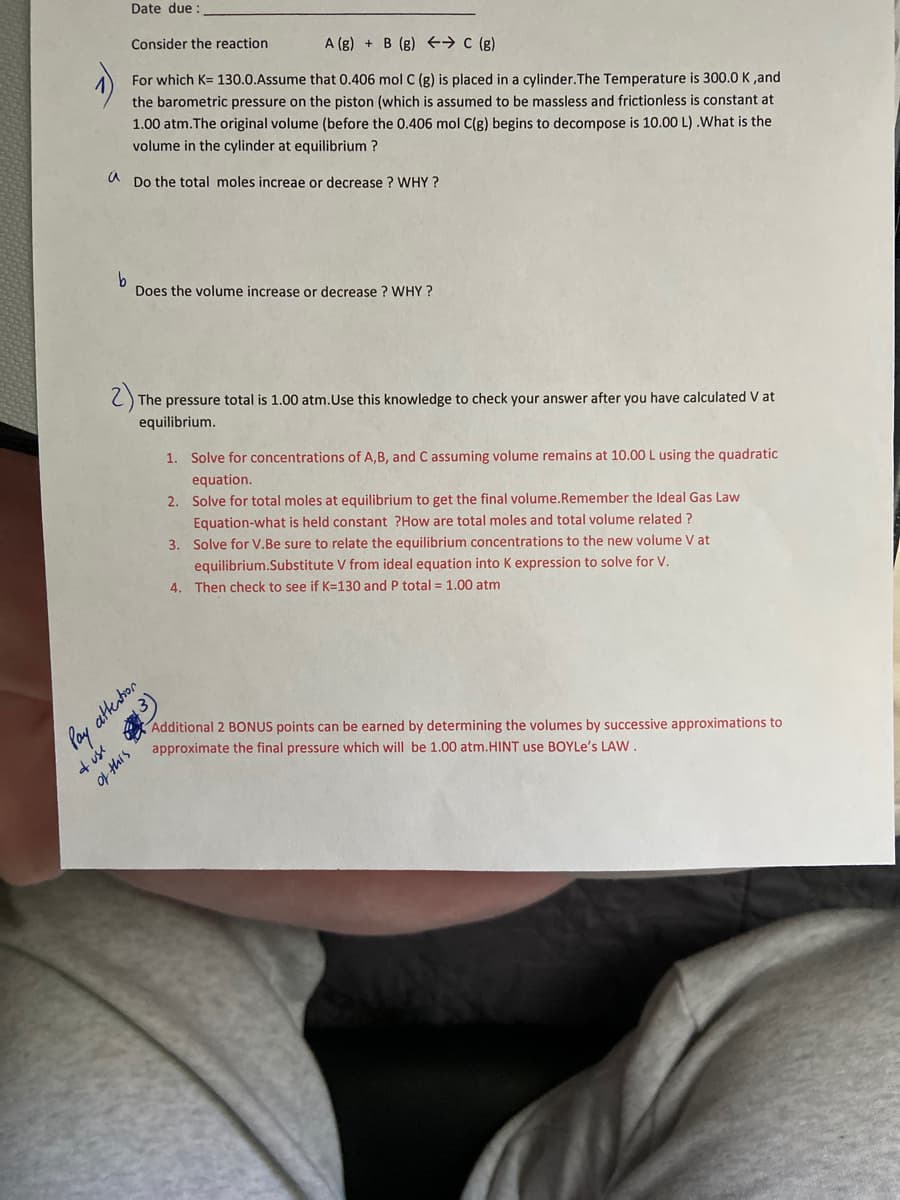For which K= 130.0.Assume that 0.406 mol C (g) is placed in a cylinder. The Temperature is 300.0 K,and the barometric pressure on the piston (which is assumed to be massless and frictionless is constant at 1.00 atm. The original volume (before the 0.406 mol C(g) begins to decompose is 10.00 L) .What is the volume in the cylinder at equilibrium ?
For which K= 130.0.Assume that 0.406 mol C (g) is placed in a cylinder. The Temperature is 300.0 K,and the barometric pressure on the piston (which is assumed to be massless and frictionless is constant at 1.00 atm. The original volume (before the 0.406 mol C(g) begins to decompose is 10.00 L) .What is the volume in the cylinder at equilibrium ?
General Chemistry - Standalone book (MindTap Course List)
11th Edition
ISBN:9781305580343
Author:Steven D. Gammon, Ebbing, Darrell Ebbing, Steven D., Darrell; Gammon, Darrell Ebbing; Steven D. Gammon, Darrell D.; Gammon, Ebbing; Steven D. Gammon; Darrell
Publisher:Steven D. Gammon, Ebbing, Darrell Ebbing, Steven D., Darrell; Gammon, Darrell Ebbing; Steven D. Gammon, Darrell D.; Gammon, Ebbing; Steven D. Gammon; Darrell
Chapter18: Thermodynamics And Equilibrium
Section: Chapter Questions
Problem 18.29QP
Related questions
Question
Provide clear explanation and show work to all questions. Thank you

Transcribed Image Text:Date due:
A (g) + B (g) → C (g)
For which K= 130.0.Assume that 0.406 mol C (g) is placed in a cylinder.The Temperature is 300.0 K, and
the barometric pressure on the piston (which is assumed to be massless and frictionless is constant at
1.00 atm. The original volume (before the 0.406 mol C(g) begins to decompose is 10.00 L) .What is the
volume in the cylinder at equilibrium ?
Consider the reaction
a
Do the total moles increae or decrease? WHY?
& use
b
Does the volume increase or decrease? WHY?
2)₁
The pressure total is 1.00 atm.Use this knowledge to check your answer after you have calculated V at
equilibrium.
Pay attention
$14-10
1. Solve for concentrations of A,B, and C assuming volume remains at 10.00 L using the quadratic
equation.
2. Solve for total moles at equilibrium to get the final volume.Remember the Ideal Gas Law
Equation-what is held constant ?How are total moles and total volume related ?
3. Solve for V.Be sure to relate the equilibrium concentrations to the new volume V at
equilibrium.Substitute V from ideal equation into K expression to solve for V.
4. Then check to see if K=130 and P total = 1.00 atm
Additional 2 BONUS points can be earned by determining the volumes by successive approximations to
approximate the final pressure which will be 1.00 atm.HINT use BOYLe's LAW.
Expert Solution
This question has been solved!
Explore an expertly crafted, step-by-step solution for a thorough understanding of key concepts.
This is a popular solution!
Trending now
This is a popular solution!
Step by step
Solved in 4 steps

Knowledge Booster
Learn more about
Need a deep-dive on the concept behind this application? Look no further. Learn more about this topic, chemistry and related others by exploring similar questions and additional content below.Recommended textbooks for you

General Chemistry - Standalone book (MindTap Cour…
Chemistry
ISBN:
9781305580343
Author:
Steven D. Gammon, Ebbing, Darrell Ebbing, Steven D., Darrell; Gammon, Darrell Ebbing; Steven D. Gammon, Darrell D.; Gammon, Ebbing; Steven D. Gammon; Darrell
Publisher:
Cengage Learning


Chemistry: An Atoms First Approach
Chemistry
ISBN:
9781305079243
Author:
Steven S. Zumdahl, Susan A. Zumdahl
Publisher:
Cengage Learning

General Chemistry - Standalone book (MindTap Cour…
Chemistry
ISBN:
9781305580343
Author:
Steven D. Gammon, Ebbing, Darrell Ebbing, Steven D., Darrell; Gammon, Darrell Ebbing; Steven D. Gammon, Darrell D.; Gammon, Ebbing; Steven D. Gammon; Darrell
Publisher:
Cengage Learning


Chemistry: An Atoms First Approach
Chemistry
ISBN:
9781305079243
Author:
Steven S. Zumdahl, Susan A. Zumdahl
Publisher:
Cengage Learning

Chemistry
Chemistry
ISBN:
9781305957404
Author:
Steven S. Zumdahl, Susan A. Zumdahl, Donald J. DeCoste
Publisher:
Cengage Learning

Chemistry: Principles and Reactions
Chemistry
ISBN:
9781305079373
Author:
William L. Masterton, Cecile N. Hurley
Publisher:
Cengage Learning

Chemistry & Chemical Reactivity
Chemistry
ISBN:
9781133949640
Author:
John C. Kotz, Paul M. Treichel, John Townsend, David Treichel
Publisher:
Cengage Learning